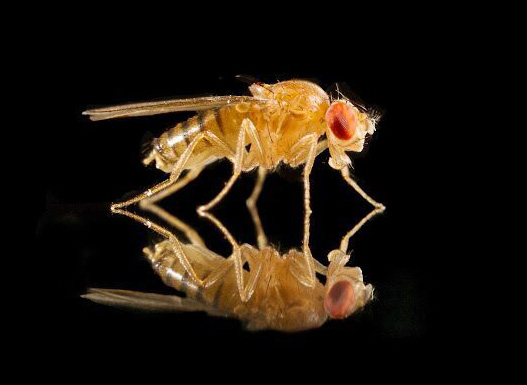Gene discovery suggests surprising evolutionary pattern
By Krishna Ramanujan

Cornell researchers have discovered a gene in Drosophila (fruit flies) that predicts whether an individual fly will be susceptible or resistant to bacterial infection.
The gene comes in different forms, called alleles, and encodes for cells to secrete a protein called an antimicrobial peptide (AMP) that kills bacterial pathogens. The ancestral form of this gene gives fruit flies resistance to infection, but susceptible alleles have arisen that do not provide such protection. Fruit flies with susceptible alleles are much more likely to die from infection and carry much higher pathogen burdens.
The findings, published Jan. 25 in the journal Current Biology, are surprising because previous research has indicated that most adaptive evolution in insect immune systems is concentrated in signaling or regulatory genes – genes that control the expression of proteins in other genes – and that those are the genes that primarily determine resistance to infections. But this AMP gene is not a regulatory gene, yet it strongly affects resistance and shows unusual signs of natural selection.
“The conventional wisdom on the evolution of insect immunity was that all of natural selection pressure was on regulatory and signaling genes and that AMP genes were not important in that way, but we show that is not true,” said Brian Lazzaro, professor of entomology and the paper’s senior author. Co-first authors include postdoctoral researcher Rob Unckless and Virginia Howick, a former graduate student, both in Lazzaro’s lab.
The researchers found that the same susceptible forms of this AMP gene arose independently in at least five Drosophila species over evolutionary time.
“That is highly unusual,” said Lazzaro. Usually, alleles that lower immunity are removed from the gene pool over time by natural selection, but these alleles that make Drosophila more susceptible keep forming and enduring in Drosophila species. “There has to be a reason for this, but we don’t know what it is,” Lazzaro said.
“This is not the way insect immune systems are typically thought to evolve, but we argue that previous studies have not been conducted in such a way that patterns like this would be detected,” Lazzaro added. “In another paper that will appear in a couple of months, we systematically look for events like this and find that they are more common in the immune system than we anticipated.”
The researchers believe the pattern may be an example of balancing selection, where two different alleles are both maintained in a population because neither is universally good nor bad, and each form can be advantageous in different circumstances.
The study was funded by the National Institutes of Health.
Media Contact
Get Cornell news delivered right to your inbox.
Subscribe